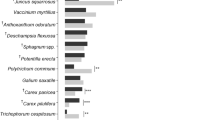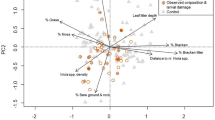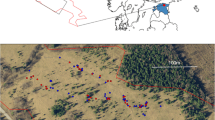Abstract
Understanding the factors that determine habitat quality is vital to ensuring appropriate habitat management. The main objective of this study was to assess the microhabitat preferences of egg-depositing females of the Grizzled Skipper (Pyrgus malvae) in calcareous grasslands of the Diemel Valley (Central Germany) for defining habitat quality. Based on this knowledge, we make management recommendations for the conservation of this threatened species. P. malvae generally preferred open and warm oviposition sites. However, there were considerable differences in the environmental conditions, depending on the selected host plant. On the small Potentilla tabernaemontani plants that grew in sparse vegetation with low-growing turf, mostly only one egg was found per plant. In contrast, occupied Agrimonia eupatoria host plants were larger and more prominent, regularly having more than one egg, and grew at sites with a taller and denser vegetation. The observed oviposition pattern reflects a trade-off between microclimate and food availability: Usually, occupied P. tabernaemontani plants grow under favourable microclimatic conditions. However, during hot years the risk of desiccation is high, leading to food shortage. In contrast, A. eupatoria generally provides more biomass, thrives on deeper soils and the vegetation has a cooler microclimate: hence, food shortage is somewhat unlikely. To meet the described habitat requirements of P. malvae, traditional rough grazing by sheep and goats seemed to be the most appropriate land management strategy. The re-introduction of coppicing in woodlands, particularly adjacent to calcareous grasslands, would also be beneficial.




Similar content being viewed by others
References
Anthes N, Fartmann T, Hermann G, Kaule G (2003) Combining larval habitat quality and meta-population structure—the key for successful management of pre-Alpine Euphydryas aurinia colonies. J Insect Conserv 7:175–185
Anthes N, Fartmann T, Hermann G (2008) The Duke of Burgundy butterfly and its dukedom: larval niche variation in Hamearis lucina across Central Europe. J Insect Conserv 12:3–14. doi:10.1007/s10841-007-9084-7
Asher J, Warren M, Fox R, Harding P, Jeffcoate G, Jeffcoate S (2001) The millenium atlas of butterflies in Britain and Ireland. Oxford University Press, Oxford
Bates D, Maechler M, Dai B (2008) lme4: linear mixed-effects models using S4 classes. R package version 0.999375-28. http://lme4.r-forge.r-project.org
Bergström A, Janz N, Nylin S (2006) Putting more eggs in the best basket: clutch-size regulation in the comma butterfly. Ecol Entomol 31:255–260
Bos FG, Bosveld MA, Groenendijk DG, van Swaay CAM, Wynhoff I (2006) De dagvlinders van Nederland. Verspreiding en bescherming. Nederlandse Fauna 7. KNNV Uitgeverij, Leiden
Bourn NAD, Thomas JA (2002) The challenge of conserving grassland insects at the margins of their range in Europe. Biol Conserv 104:285–292
Brereton TM, Bourn NAD, Warren MS (1998) Species action plan. Grizzled Skipper (Pyrgus malvae). Butterfly Conservation, Wareham
Clarke RT, Thomas JA, Elmes GW, Hochberg ME (1997) The effects of spatial patterns on habitat quality on community dynamics within a site. P Roy Soc Lond B Biol 264:347–354
Courtney SP (1982) Coevolution of pierid butterflies and their cruciferous host plants. IV. Host apparency and Anthocharis cardamines oviposition. Oecologia 52:258–265
Courtney SP (1984) Habitat versus foodplant selection. In: Vane-Wright RI, Ackery PR (eds) The biology of butterflies. Academic Press, London, pp 89–90
Dennis RLH, Shreeve TG, van Dyck H (2006) Habitats and resources: the need for a resource-based definition to conserve butterflies. Biodivers Conserv 15:1943–1966
Ebert G, Rennwald E (1991) Die Schmetterlinge Baden-Württembergs. Band 1, Tagfalter I. Eugen Ulmer, Stuttgart
Ehrlich PR, Hanski I (eds) (2004) On the wings of checkerspots: a model system for population biology. Oxford University Press, Oxford
Eichel S, Fartmann T (2008) Management of calcareous grasslands for Nickerl’s fritillary (Melitaea aurelia) has to consider habitat requirements of the immature stages, isolation, and patch area. J Insect Conserv 12:677–688. doi:10.1007/s10841-007-9110-9
Fartmann T (2004) Die Schmetterlingsgemeinschaften der Halbtrockenrasen-Komplexe des Diemeltales. Biozönologie von Tagfaltern und Widderchen in einer alten Hudelandschaft. Abh Westf Mus Naturk 66:1–256
Fartmann T (2006) Oviposition preferences, adjacency of old woodland and isolation explain the distribution of the Duke of Burgundy butterfly (Hamearis lucina) in calcareous grasslands in central Germany. Ann Zool Fenn 43:335–347
Fox R, Asher J, Brereton T, Roy D, Warren M (2006) The state of butterflies in Britain and Ireland. Information Press, Oxford
García-Barros E, Fartmann T (2009) Butterfly oviposition: sites, behaviour and modes. In: Settele J, Konvicka M, Shreeve T, van Dyck H (eds) Ecology of butterflies in Europe. Cambridge University Press, Cambridge, pp 29–42
Küer A, Fartmann T (2005) Prominent shoots are preferred: microhabitat preferences of Maculinea alcon (Denis & Schiffermüller, 1775) in northern Germany (Lycaenidae). Nota lepidopterologica 27:309–319
McCune B, Keon D (2002) Equations for potential annual direct incident radiation and heat load. J Veg Sci 13:603–606
Munguira M, García-Barros E, Cano JM (2009) Butterfly herbivory and larval ecology. In: Settele J, Shreeve TG, Konvicka M, van Dyck H (eds) Ecology of butterflies in Europe. Cambridge University Press, Cambridge, pp 43–54
Nieminen M, Singer M, Fortelius W, Schöps K, Hanski I (2001) Experimental confirmation that inbreeding depression increases extinction risk in butterfly populations. Am Nat 157:237–244
Ohsaki N, Sato Y (1994) Food plant choice of Pieris butterflies as a trade-off between parasitoid avoidance and quality of plants. Ecology 75:59–68
Piessens K, Adriaens D, Jacquemyn H, Honnay O (2009) Synergistic effects of an extreme weather event and habitat fragmentation on a specialised insect herbivore. Oecologia 159:117–126
Poniatowski D, Fartmann T (2008) The classification of insect communities: lessons from Orthoptera assemblages of semi-dry calcareous grasslands in central Germany. Eur J Entomol 105:659–671
Poniatowski D, Fartmann T (2010) What determines the distribution of a flightless bush-cricket (Metrioptera brachyptera) in a fragmented landscape? J Insect Conserv 14:637–645. doi:10.1007/s10841-010-9293-3
Porter K (1992) Eggs and egg-laying. In: Dennis RLH (ed) The ecology of butterflies in Britain. Oxford University Press, Oxford, pp 46–72
Reinhardt R, Bolz R (eds) (in press) Rote Liste der Tagfalter (Rhopalocera) (Lepidoptera: Papilionoidea et Hesperioidea). Natursch Biol Vielfalt 70
Roy DB, Thomas JA (2003) Seasonal variation in the niche, habitat availability and population fluctuations of a bivoltine thermophilous insect near its range margin. Oecologia 134:439–444
Sato Y, Yano S, Takabayashi J, Ohsaki N (1999) Pieris rapae (Lepidoptera: Pieridae) females avoid oviposition on Rorippa indica plants infested by conspecific larvae. Appl Entomol Zool 34:333–337
Shreeve TG (1986) Egg-laying by the speckled wood butterfly Pararge aegeria: the role of female behaviour, host plant abundance and temperature. Ecol Entomol 11:229–236
Slater M (2007) Creation of a drystone wall to create egg-laying habitat for Grizzled Skipper Pyrgus malvae at Ryton Wood Meadows Butterfly Conservation Reserve, Warwickshire, England. Conserv Evid 4:35–40
Stoutjesdijk P, Barkman JJ (1992) Microclimate, vegetation and fauna. Opulus Press, Uppsala
R Development Core Team (2009) R: a language and environment for statistical computing. R Foundation for Statistical Computing, Vienna, Austria. ISBN 3 900051-07-0, URL http://www.R-project.org
Thomas JA (1991) Rare species conservation: case studies of European butterflies. In: Spellerberg IF, Goldsmith FB, Morris MG (eds) The scientific management of temperate communities for conservation. Blackwell Scientific, Oxford, pp 149–197
Thomas JA (2005) Monitoring change in the abundance and distribution of insects using butterflies and other indicator groups. Philos T Roy Soc B 360:339–357
Thomas JA, Clarke RT (2004) Extinction rates and butterflies. Science 305:1563–1564
Thomas JA, Elmes GW (2001) Food-plant niche selection rather than the presence of ant nests explains oviposition patterns in the myrmecophilous butterfly genus Maculinea. P Roy Soc Lond B Biol 268:471–477
Thomas JA, Simcox DJ, Wardlaw JC, Elmes GW, Hochberg ME, Clarke RT (1998) Effects of latitude, altitude and climate on the habitat and conservation of the endangered butterfly Maculinea arion and its Myrmica ant hosts. J Insect Conserv 2:39–46
Thomas JA, Bourn NAD, Clarke RT, Stewart KE, Simcox DJ, Pearman GS, Curtis R, Goodger B (2001) The quality and isolation of habitat patches both determine where butterflies persist in fragmented landscapes. P Roy Soc Lond B Biol 268:1791–1796
Thomas JA, Telfer MG, Roy DB, Preston CD, Greenwood JJD, Asher J, Fox R, Clarke RT, Lawton JH (2004) Comparative losses of British butterflies, birds, and plants and the global extinction crisis. Science 303:1879–1881
Tonne F (1954) Besser bauen mit Besonnungs- und Tageslichtplanung. Hofmann, Schondorf
van Swaay CAM, Warren MS (1999) Red data book of European butterflies (Rhopalocera). Nat Environ 99:1–260
Wagner W (2006) Die Gattung Pyrgus in Mitteleuropa und ihre Ökologie—Larvalhabitate, Nährpflanzen und Entwicklungszyklen. In: Fartmann T, Hermann G (eds) Larvalökologie von Tagfaltern und Widderchen in Mitteleuropa. Abh Westf Mus Naturk 68:83–122
Warren MS, Thomas JA (1992) Butterfly responses to coppicing. In: Buckley GP (ed) Ecology and management of coppice woodlands. Chapman & Hall, London, pp 249–270
Watt WB, Boggs CL (2003) Synthesis: butterflies as model systems in ecology and evolution—present and future. In: Boggs CL, Watt WB, Ehrlich PR (eds) Butterflies—ecology and evolution taking flight. The University of Chicago Press, Chicago, pp 603–613
Weiss SB, Murphy DD, White RR (1988) Sun, slope, and butterflies: topographic determinants of habitat quality for Euphydryas editha. Ecology 69:1486–1496
Wiklund C (1984) Egg-laying patterns in butterflies in relation to their phenology and the visual apparency and abundance of their host plants. Oecologia 63:23–29
Acknowledgments
We are very grateful to Kerstin Gonschorrek, Anna Jess, Johanna Römer and Merle Streitberger for support during field work. Moreover, we would like to thank Gabriel Hermann and one anonymous reviewer for valuable comments on an earlier version of the manuscript.
Author information
Authors and Affiliations
Corresponding author
Rights and permissions
About this article
Cite this article
Krämer, B., Kämpf, I., Enderle, J. et al. Microhabitat selection in a grassland butterfly: a trade-off between microclimate and food availability. J Insect Conserv 16, 857–865 (2012). https://doi.org/10.1007/s10841-012-9473-4
Received:
Accepted:
Published:
Issue Date:
DOI: https://doi.org/10.1007/s10841-012-9473-4




